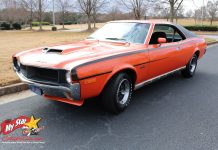A car guy in our area is generous with his opinions and not shy about sharing them.
He has built numerous custom street rods over the years and is true to the old school of original metal vintage vehicles as a base platform for his 4-wheeled creations.
We ran into him at an early September car show and were surprised to learn there are certain Chevy vehicles that he does not like, including the famous Tri-Five models, given the fact he is a dyed-in-the-wool fan of the Bowtie brand.
Jim Sutherland
However, he hates the 1949-54 Chevys much more than the 1955-57 Chevy models and would own a Tri-Five long before its immediate predecessors if he was forced to choose between the two Bowtie eras. We at MyStarCollectorCar respectfully disagree with our local car guy legend and would like to offer five reasons why the 1949-54 Chevys earned our respect.

The first reason is simple: 1949 marked the debut of a fresh-new design for many domestic cars (including Chevrolet) during the post-war era. World War Two meant car builders were forced to produce vehicles with an outdated design from the early 1940s when car builders became military equipment builders. 1949 was the year when Chevy launched into the future and built a radically different style of car from its 1948 model. One could argue the post-war Chevys finally arrived in 1949, and they could be found at the local dealership.
The second reason was the 1950 Chevy Bel Air Sport Coupe because the car was the first hardtop model sold by the Blue Oval boys. The hardtop was named because it had a fixed metal top with no middle post (B-pillar) between the front and rear passenger areas, consequently it provided a quasi-convertible experience with a more open feel for its passengers and a metal roof to protect them.

The two-door hardtop design also made the early 1950s Chevys look cooler and faster in our opinion here at MyStarCollectorCar.
The third reason relates to the first two reasons because the then-new Chevy design also lent itself to genuine convertible models that showcased their overall style.

Drop top Chevys from 1949 to ‘54 have the right curves to give the cars a classic sporty appearance with a timeless quality. Just imagine rolling down Route 66 in a 1953 Chevy convertible while listening to Dinah Shore singing ‘See The USA In Your Chevrolet’ and you get the picture.

The fourth reason is Chevy introduced the 2-speed Powerglide automatic transmission as an option in 1950, although it could be more accurately described as a semi-automatic because drivers needed to shift it from low to high range. But it had no manual clutch. The shift process became completely automatic in 1953 Chevys equipped with Powerglide trannies and marked the car’s evolution into a driver-friendly car.

The fifth and final reason is 1949 Chevys evolved into 1954 models via subtle style changes over the five years and got better-looking every year. The net result was a distinctly different style of Chevy by 1954, but one that owed its lineage to the 1949 Chevy in many ways.
It was a smooth transition that made the 1949-54 Chevies legends in our opinion here at MyStarCollectorCar. Just not so much in the eyes of our local car guy.
Jim Sutherland
BY: Jim Sutherland
Jim Sutherland is a veteran automotive writer whose work has been published by many major print and online publications. The list includes Calgary Herald, The Truth About Cars, Red Deer Advocate, RPM Magazine, Edmonton Journal, Montreal Gazette, Windsor Star, Vancouver Province, and Post Media Wheels Section.
- CLICK HERE to Sign Up for the Newsletter
- CLICK HERE to Like us on Facebook
- CLICK HERE to Follow us on Twitter
- CLICK HERE to Follow us on Pinterest
























































